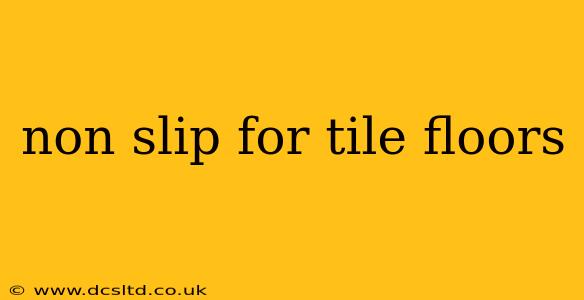Tile floors offer elegance and easy maintenance, but their smooth surfaces can become dangerously slippery, especially when wet. This comprehensive guide explores various non-slip options for tile floors, helping you choose the best solution for your home's safety and aesthetic needs. We'll cover everything from simple preventative measures to more extensive renovations, answering common questions along the way.
What are the best non-slip products for tile floors?
The best non-slip product for your tile floors depends on several factors, including your budget, the type of tile, and the level of slipperiness. Here are some popular options:
-
Non-Slip Mats and Rugs: These are a simple, affordable, and readily available solution. Place mats in high-traffic areas like entrances, bathrooms, and kitchens. Choose rugs with rubber backing for optimal grip. Consider textured materials like jute or coir for added traction.
-
Non-Slip Tapes and Strips: Ideal for smaller areas or specific spots prone to spills, these adhesive tapes provide temporary or semi-permanent non-slip surfaces. They're particularly useful in shower stalls or around tubs. Ensure the tape is suitable for tile and is applied correctly.
-
Non-Slip Floor Coatings: These coatings provide a long-lasting non-slip surface by chemically altering the tile's texture. They are generally more expensive than other options but offer superior protection. Professional application is often recommended.
-
Non-Slip Floor Polish: Applying a specialized non-slip floor polish can enhance traction without significantly altering the tile's appearance. This option provides a temporary solution requiring regular reapplication.
-
Abrasive Cleaning Pads: These pads, used during cleaning, can slightly roughen the tile surface, improving grip. However, this method is relatively mild and may not be sufficient for severely slippery tiles.
How can I make my tile floor less slippery?
Making your tile floor less slippery involves a multi-pronged approach that combines prevention with proactive solutions. Here are some key strategies:
-
Regular Cleaning: Regularly clean your tile floors to remove dirt, grime, and soap residue which can make the surface more slippery. Use a suitable tile cleaner and avoid leaving excess water on the floor.
-
Doormats: Place doormats both inside and outside entrances to trap dirt and moisture before it reaches your tile floors. This simple step significantly reduces the risk of slips and falls.
-
Proper Lighting: Ensure adequate lighting in areas with tile floors, particularly bathrooms and kitchens. Good lighting helps to improve visibility and reduce the likelihood of accidents.
-
Proper Grout Cleaning: Clean grout regularly to prevent the build-up of dirt and mildew, which can increase slipperiness. Consider sealing your grout to make cleaning easier.
What causes tile floors to be slippery?
Tile floors can become slippery due to several factors:
-
Smooth Surface: The inherent smoothness of most tiles makes them prone to slipperiness, especially when wet.
-
Soap and Cleaning Residue: Soap scum, detergent residue, and other cleaning products can create a thin, slippery film on the tile surface.
-
Water: Water is the most common culprit. Spills, leaks, or even humidity can make tile floors extremely hazardous.
-
Type of Tile: Some types of tile, such as polished porcelain or marble, are inherently more slippery than others.
Are there non-slip tile options available?
Yes, many non-slip tile options are available. Look for tiles with a textured surface or a higher coefficient of friction (COF). Textured tiles offer better grip and are less likely to become slippery when wet. Check the COF rating before purchasing tiles; a higher COF indicates greater slip resistance.
How much does it cost to make tile floors non-slip?
The cost of making tile floors non-slip varies significantly depending on the chosen method. Non-slip mats and rugs are the most affordable option, while professional floor coating applications can be considerably more expensive. The cost also depends on the size of the area needing treatment.
What is the coefficient of friction (COF) for tile?
The coefficient of friction (COF) measures the resistance to slippage between two surfaces. For tile floors, a higher COF indicates greater slip resistance. The ideal COF for non-slip tile flooring is generally above 0.6, but this can vary depending on the specific application and standards. Always check the manufacturer's specifications for the COF of your chosen tiles.
By carefully considering these options and implementing appropriate preventative measures, you can significantly improve the safety and comfort of your tile floors, transforming potentially hazardous areas into safe and stylish spaces. Remember to always prioritize safety and choose the solution that best fits your individual needs and budget.
